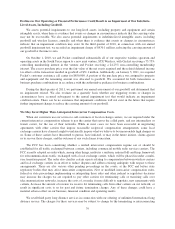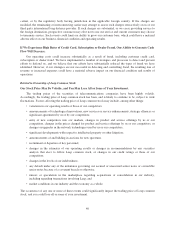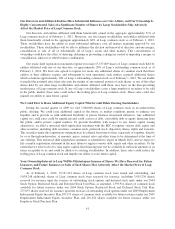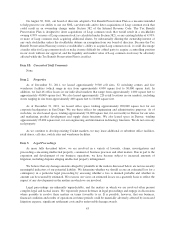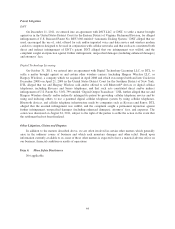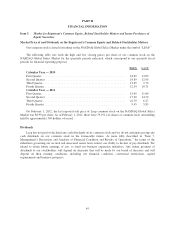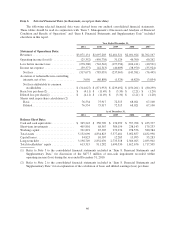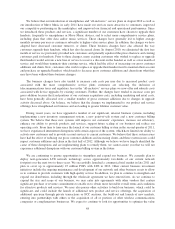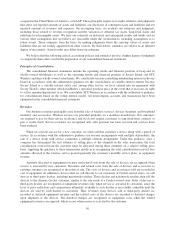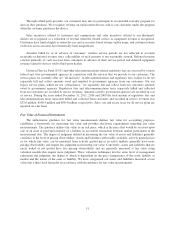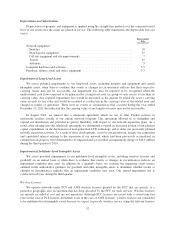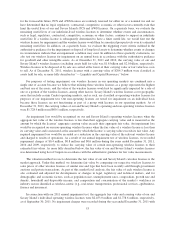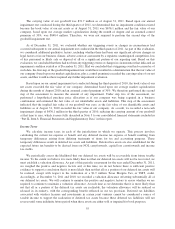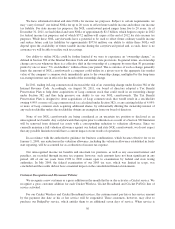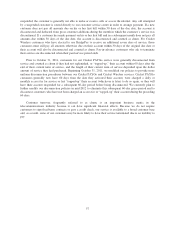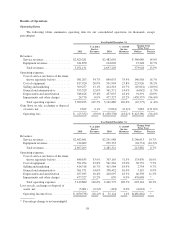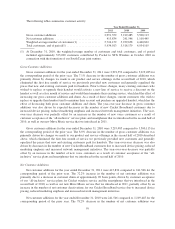Cricket Wireless 2011 Annual Report Download - page 59
Download and view the complete annual report
Please find page 59 of the 2011 Cricket Wireless annual report below. You can navigate through the pages in the report by either clicking on the pages listed below, or by using the keyword search tool below to find specific information within the annual report.of our spectrum portfolio. Because some of the licenses that we hold include large regional areas covering both
rural and metropolitan communities, we may seek to partner with others, sell some of this spectrum or pursue
alternative products or services to utilize or benefit from the spectrum not currently used for Cricket service. We
intend to be disciplined as we pursue any investment initiatives and to remain focused on our position as a
low-cost provider of wireless telecommunications.
Our customer activity is influenced by seasonal effects related to traditional retail selling periods and other
factors that arise in connection with our target customer base. Based on historical results, we generally expect
new sales activity to be highest in the first and fourth quarters and customer turnover, or churn, to be highest in
the third quarter and lowest in the first quarter. Sales activity and churn, however, can be strongly affected by
other factors, including changes in service plan pricing, promotional activity, device availability, economic
conditions, high unemployment (particularly in the lower-income segment of our customer base) and competitive
actions or the relative amount of time a market has been in operation, any of which may have the ability to either
offset or magnify certain seasonal effects. From time to time, we have experienced inventory shortages, most
notably with certain of our strongest-selling devices, and these shortages have had the effect of limiting the
customer activity that would otherwise have been expected based on seasonal trends. We also design and offer
marketing programs and promotions, including device and accessory discounts, to help increase customer
activity for our wireless services which may affect seasonal trends. The frequency and timing of these programs
and promotions vary depend upon marketing conditions, competition and our operating performance. For
example, we utilize a program which allows existing customers to activate an additional line of voice service on
a previously activated Cricket device not currently in service. Customers accepting this offer receive a free first
month of service on the additional line of service after paying an activation fee. We also offer certain former
customers an initial free month of service as an incentive to reinstate their service with Cricket and offer certain
other customers whose accounts have been suspended for failing to timely pay their bill the opportunity to
reinstate their service for a discounted amount or a free month of service. We increased our use of these offers in
the fourth quarter of 2011 to increase customer activity and to offset in part the effect of the intermittent billing
system disruptions we experienced in 2011. Although some customers who reinstate service under these
programs may churn at a faster rate than the average customer, we believe that these kinds of programs and other
promotions provide important long-term benefits to us by extending the period of time over which customers use
our wireless services.
The wireless telecommunications industry is very competitive. In general, we compete with national
facilities-based wireless providers and their prepaid affiliates or brands, local and regional carriers, non-facilities-
based MVNOs, voice-over-internet-protocol service providers, traditional landline service providers, cable
companies, and mobile satellite service providers. A number of our competitors offer competitively priced
unlimited prepaid and postpaid service offerings. In addition to the general competition we face, these service
offerings present additional strong competition in markets in which our offerings overlap. In response to the
evolving wireless telecommunications market, we substantially revised our product and service offerings
beginning in the second half of 2010 and these changes improved our operating and financial performance. As
consolidation in the industry continues and creates even larger competitors, advantages that these competitors
may have, as well as their bargaining power as wholesale providers of roaming services, may increase. Our
ability to remain competitive will depend, in part, on our ability to anticipate and respond to various competitive
factors and to keep our costs low.
Our principal sources of liquidity are our existing unrestricted cash, cash equivalents and short-term
investments and cash generated from operations. From time to time, we may also generate additional liquidity by
selling non-core assets or through future capital markets transactions. See “—Liquidity and Capital Resources”
below.
Critical Accounting Policies and Estimates
Our discussion and analysis of our results of operations and liquidity and capital resources are based on our
consolidated financial statements which have been prepared in accordance with accounting principles generally
49


